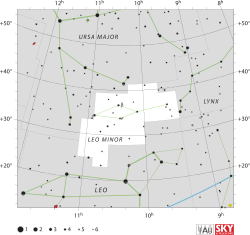30 Leonis Minoris
30 Leonis Minoris, som är stjärnans Flamsteed-beteckning, är en ensam stjärna,[11] belägen i den mellersta delen av stjärnbilden Lilla lejonet. Den har en skenbar magnitud av ca 4,72[2] och är svagt synlig för blotta ögat där ljusföroreningar ej förekommer. Baserat på parallaxmätning inom Hipparcosuppdraget på ca 14,0[1] mas, beräknas den befinna sig på ett avstånd på ca 233 ljusår (ca 72 parsek) från solen. Den rör sig bort från solen med en heliocentrisk radialhastighet på ca 14 km/s.[6]
| 30 Leonis Minoris | |
 | |
| Observationsdata Epok: J2000.0 | |
|---|---|
| Stjärnbild | Lilla lejonet |
| Rektascension | 10t 25m 54,81535s[1] |
| Deklination | +33° 47′ 46,0309″[1] |
| Skenbar magnitud () | +4,72 (V)[2] |
| Stjärntyp | |
| Spektraltyp | kF0 hF2 mF2[3] eller A9 IIIa[4] |
| U–B | +0,18[5] |
| B–V | +0,25[5] |
| Astrometri | |
| Radialhastighet () | +13,70[6] km/s |
| Egenrörelse (µ) | RA: -73,66[1] mas/år Dek.: -59,21[1] mas/år |
| Parallax () | 13,98 ± 0,21[1] |
| Avstånd | 233 ± 4 lå (72 ± 1 pc) |
| Absolut magnitud () | +0,45[2] |
| Detaljer | |
| Massa | 2,28[7] M☉ |
| Radie | 4,182[8] R☉ |
| Luminositet | 58[7] L☉ |
| Temperatur | 7 292[9] K |
| Metallicitet | +0,19(Fe/H)[9] dex |
| Vinkelhastighet | 34[7] km/s |
| Andra beteckningar | |
| 30 Lmi, AG+34 1086, BD+34 2128, GSC 02514-01294, HD 90277, HIC 51056, HIP 51056, HR 4090, IRAS 10230+3403, 2MASS J10255481+3347462, PPM 75214, SAO 62038, TD1 14824, TYC 2514-1294-1, uvby98 100090277, WISEA J102554.74+334745.4, Gaia DR2 749214855324239232 [10] | |
Egenskaper redigera
30 Leonis Minoris är en gul till vit stjärna i huvudserien av spektralklass kF0 hF2 mF2,[3] som anger att dess spektrum har kalcium-K-linjen för en F0-stjärna, och väte- och metallinjerna för en F2-stjärna. Den har katalogiserats som en Am-stjärna[12] och Gray et al. (2001) tilldelade den spektralklass A9 IIIa.[4] Den har en massa som är ca 2,3[7] solmassor, en radie som är ca 4,2[8] solradier och utsänder från dess fotosfär ca 58[7] gånger mera energi än solen vid en effektiv temperatur av ca 7 300[8] K.
Referenser redigera
- Den här artikeln är helt eller delvis baserad på material från engelskspråkiga Wikipedia, 30 Leonis Minoris, 24 april 2020.
Noter redigera
- ^ [a b c d e f] Van Leeuwen, F. (2007). "Validation of the new Hipparcos reduction". Astronomy and Astrophysics. 474 (2): 653. arXiv:0708.1752. Bibcode:2007A&A...474..653V. doi:10.1051/0004-6361:20078357. Vizier catalog entry
- ^ [a b c] Anderson, E.; Francis, Ch. (2012). "XHIP: An extended hipparcos compilation". Astronomy Letters. 38 (5): 331. arXiv:1108.4971. Bibcode:2012AstL...38..331A. doi:10.1134/S1063773712050015. Vizier catalog entry
- ^ [a b] Abt, Helmut A.; Morrell, Nidia I. (1995). "The Relation between Rotational Velocities and Spectral Peculiarities among A-Type Stars". Astrophysical Journal Supplement. 99: 135. Bibcode:1995ApJS...99..135A. doi:10.1086/192182.
- ^ [a b] Gray, R. O.; et al. (April 2001). "The Physical Basis of Luminosity Classification in the Late A-, F-, and Early G-Type Stars. I. Precise Spectral Types for 372 Stars". The Astronomical Journal. 121 (4): 2148–2158. Bibcode:2001AJ....121.2148G. doi:10.1086/319956.
- ^ [a b] Mallama, A. (2014). "Sloan Magnitudes for the Brightest Stars". The Journal of the American Association of Variable Star Observers. 42: 443. Bibcode:2014JAVSO..42..443M.Vizier catalog entry
- ^ [a b] Gontcharov, G. A. (2006). "Pulkovo Compilation of Radial Velocities for 35 495 Hipparcos stars in a common system". Astronomy Letters. 32 (11): 759. arXiv:1606.08053. Bibcode:2006AstL...32..759G. doi:10.1134/S1063773706110065.
- ^ [a b c d e] Zorec, J.; Royer, F. (2012). "Rotational velocities of A-type stars". Astronomy & Astrophysics. 537: A120. arXiv:1201.2052. Bibcode:2012A&A...537A.120Z. doi:10.1051/0004-6361/201117691. Vizier catalog entry
- ^ [a b c] Masana, E.; et al. (2006). "Effective temperature scale and bolometric corrections from 2MASS photometry". Astronomy and Astrophysics. 450 (2): 735. arXiv:astro-ph/0601049. Bibcode:2006A&A...450..735M. doi:10.1051/0004-6361:20054021. Vizier catalog entry
- ^ [a b] Wu, Yue; et al. (2010). "Coudé-feed stellar spectral library – atmospheric parameters". Astronomy & Astrophysics. 525: A71. arXiv:1009.1491. Bibcode:2011A&A...525A..71W. doi:10.1051/0004-6361/201015014.
- ^ "30 LMi". SIMBAD. Centre de données astronomiques de Strasbourg. Hämtad 2020-04-24.
- ^ Eggleton, P. P.; Tokovinin, A. A. (September 2008). "A catalogue of multiplicity among bright stellar systems". Monthly Notices of the Royal Astronomical Society. 389 (2): 869–879. arXiv:0806.2878. Bibcode:2008MNRAS.389..869E. doi:10.1111/j.1365-2966.2008.13596.x.
- ^ Shorlin, S. L. S.; et al. (September 2002). "A highly sensitive search for magnetic fields in B, A and F stars". Astronomy and Astrophysics. 392: 637–652. Bibcode:2002A&A...392..637S. doi:10.1051/0004-6361:20021192.



